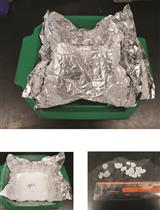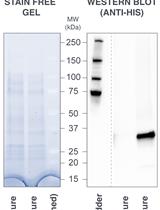- EN - English
- CN - 中文
mRNA Delivery Platform Based on Bacterial Outer Membrane Vesicles for Tumor Vaccine
基于细菌外膜囊泡的mRNA传递平台用于肿瘤疫苗
发布: 2023年07月05日第13卷第13期 DOI: 10.21769/BioProtoc.4774 浏览次数: 2925
评审: David PaulMiaowei Marwell MaoAnonymous reviewer(s)
Abstract
The rapid display and delivery method for customized tumor mRNA vaccines is limited. Herein, bacteria-derived outer membrane vesicles (OMVs) are employed as an mRNA delivery platform by surface engineering of an RNA-binding protein, L7Ae. OMV-L7Ae can rapidly adsorb boxC/D sequence-labeled mRNA antigens through L7Ae-boxC/D binding and deliver them into HEK-293T and dendritic cells. This platform provides an mRNA delivery technology distinct from lipid nanoparticles (LNPs) for personalized mRNA tumor vaccination and with a Plug-and-Display strategy suitable for rapid preparation of the personalized mRNA tumor vaccine against varied tumor antigens.
Key features
• OMVs are employed as an mRNA delivery platform through L7Ae-boxC/D binding.
Graphical overview

Background
In recent years, mRNA vaccines have emerged as a promising weapon in cancer immunotherapy (G. Liu et al., 2021). Through precise sequence design, tumor mRNA vaccines encode one or more tumor-specific antigens derived from gene mutations in tumor cells. After vaccine uptake and intracellular protein translation in antigen presenting cells (APCs), tumor-specific antigens form complexes with the major histocompatibility complex I (MHCI) that are presented to T cells to activate a robust antitumor immunity (Miao et al., 2021). However, because of its poor stability, large molecular weight, and high negative charge, mRNA vaccines must rely on efficient delivery carriers to enter APCs (Miao et al., 2019; Barbieri and Kouzarides, 2020). So far, the mainstream mRNA carriers in the clinic are lipid nanoparticles (LNPs) (Liang and Zhao, 2021), which encapsulate mRNA in nanocarriers through a microfluid-based synthesis process (C. Liu et al., 2019; Blass and Ott, 2021; Dolgin, 2021). However, due to the heterogeneity and complexity of tumor antigens, the time-consuming encapsulation process is not suitable to produce personalized tumor vaccines (Wang et al., 2022).
Outer membrane vesicles (OMVs), as biogenic nanocarriers secreted by bacteria, are rich in bacterial components, with the ability to integrate adjuvants and carriers (Cheng et al., 2021; Liang et al., 2022; Yue et al., 2022; Zhao et al., 2022). In addition, OMVs can be obtained by bacterial fermentation in large quantities, which has attracted more and more attention (Cheng et al., 2020; Gao et al., 2022). Here, we describe a Plug-and-Display strategy for mRNA antigen delivery in an OMV-based platform by arming OMVs with an RNA-binding protein, L7Ae (Li et al., 2022). BoxC/D, the matched binding sequence, is added to the 3′-untranslated region (UTR) of the in vitro–transcribed (IVT) mRNA. The archaeal RNA-binding protein L7Ae is fused to the C-terminal of the surface protein ClyA on the OMVs (OMV-L7Ae). The boxC/D sequence adopts the standard k-turn conformation that is specifically recognized by the L7Ae protein, which stabilizes the stem-loop and forms a standard L7Ae-k-turn complex (Moore et al., 2004; Turner et al., 2005; Saito et al., 2010). Through the strong and specific binding between the L7Ae protein and the boxC/D sequence, the boxC/D-labeled mRNA (boxC/D-mRNA) is rapidly adsorbed onto the surface of the OMV-L7Ae, achieving the successful mRNA delivery into cells via endocytosis of OMVs by HEK-293T or bone marrow dendritic cells (BMDCs). This Plug-and-Display strategy is suitable for the rapid preparation of tumor mRNA vaccines against heterogeneous and complex tumor antigens.
Materials and reagents
Biological materials
E. coli [strain BL21 (DE3)] (Tiangeng, catalog number: DHGST-21)
HEK-293T cells (American Type Culture Collection, catalog number: CRL-3216)
C57BL/6 mice (Vital River Laboratory Animal Technology, catalog number: 01059)
Reagents
NaCl (Solarbio, catalog number: S8210)
Yeast extract (Solarbio, catalog number: Y8020)
Tryptone (Solarbio, catalog number: T8490)
Agar (Solarbio, catalog number: A8190)
Chloramphenicol (50 mg/mL) (Solarbio, catalog number: L1311)
Isopropyl-β-d-thiogalactoside (IPTG) (Solarbio, catalog number: BS119)
Note: IPTG causes serious eye irritation. Wear nitrile gloves, safety goggles, and lab coats, and operate carefully in a fume hood.
Fetal bovine serum (FBS) (Wisent, catalog number: 085-150)
Penicillin G and streptomycin (Wisent, catalog number: 450-201-EL)
Phosphate-buffered saline (PBS) (Wisent, catalog number: 311-010-CL)
Dulbecco’s modified Eagle medium (DMEM) (Wisent, catalog number: 319-005-CL)
RPMI 1640 medium (Wisent, catalog number: 350-000-CL)
HiScribe T7 ARCA mRNA kit (with tailing) (New England Biolabs, catalog number: E2060S)
Q5 high-fidelity 2× master mix (New England Biolabs, catalog number: M0492S)
Tris-HCl (1 M, pH 8.0) (Solarbio, catalog number: T1150)
MgCl2 (1 M) (Beyotime, catalog number: ST269)
Diethylpyrocarbonate (DEPC)-treated water (Biosharp, BL510B)
Citric acid sodium citrate buffer (0.1 M, pH = 4.0) (Leagene, R00521)
Ethanol (Macklin, catalog number: E809063)
Ammonium chloride potassium (ACK) lysis buffer (Solarbio, catalog number: R1010)
HEPES (1 M, pH 7.4) (Sigma-Aldrich, catalog number: 83264)
β-Mercaptoethanol (β-ME) (Gibco, catalog number: 21985023)
IL-4 (Sino Biological, catalog number: 51084-MNAE)
Granulocyte-macrophage colony-stimulating factor (GM-CSF) (Sino Biological, catalog number: 51048-M01H)
FITC-anti-mouse CD11c (BioLegend, catalog number: 117306)
APC-anti-mouse CD80 (BioLegend, catalog number: 104713)
PE/Cy7-anti-mouse CD86 (BioLegend, catalog number: 105014)
APC-anti-mouse H-2Kb bound to SIINFEKL (BioLegend, catalog number: 141605)
pST1374-NLS-flag-linker-Cas9 plasmid (Addgene, catalog number: 44758)
Trypsin-EDTA (0.25%) (Meilunbio, catalog number: MB4376)
Solutions
Solid LB medium (see Recipes)
Liquid LB medium (see Recipes)
Reaction buffer for mRNA binding (pH = 5.0) (see Recipes)
Recipes
Solid LB medium
Reagent Final concentration Amount Yeast extract 5 g/L n/a Tryptone 10 g/L n/a NaCl 10 g/L n/a Agar 15 g/L n/a H2O n/a 100 mL Total n/a 100 mL Prepare the solid LB medium by dissolving 1.5 g of agar, 1 g of NaCl, 1 g of tryptone, and 0.5 g of yeast extract in 100 mL of deionized water. After sterilization for 20 min at 121 °C and 0.1 MPa, add 100 μL of 50 mg/mL chloramphenicol when the temperature reaches approximately 60 °C. Add 10 mL of sterilized LB medium to a dish (10 cm) after fully mixing. After solidification, seal the solid LB medium with sealing film. Store the solid LB medium for one month at 4 °C.
Note: Add antibiotics only after the temperature drops to ~50–60 °C, because their activity is seriously affected by temperature.
Liquid LB medium
Reagent Final concentration Amount Yeast extract 5 g/L n/a Tryptone 10 g/L n/a NaCl 10 g/L n/a H2O n/a 1 L Total n/a 1 L Prepare the liquid LB medium by dissolving 10 g of tryptone, 5 g of yeast extract, and 10 g of NaCl in 1 L of deionized water. After sterilization for 20 min at 121 °C and 0.1 MPa, store the liquid LB medium for one month at 4 °C.
Reaction buffer for mRNA binding (pH = 5.0)
Reagent Final concentration Amount NaCl 100 × 10-3 M n/a Tris-HCl (1 M, pH 8.0) 5 × 10-3 M 200 μL MgCl2 (1 M) 10 × 10-3 M 400 μL Total n/a 40 mL Prepare the reaction buffer for mRNA binding by dissolving 233.76 mg of NaCl in 30 mL of DEPC-treated water. Then, add 200 μL of 1 M Tris-HCl (pH = 8.0) and 400 μL of 1 M MgCl2 and fully mix. After adjusting pH to 5.0 with citric acid sodium citrate buffer, set the volume to 40 mL. Seal the reaction buffer for mRNA binding with sealing film and store the reaction buffer for mRNA binding for one month at 4 °C.
Note: To prevent the introduction of RNA enzymes, water must be DEPC treated.
Laboratory supplies
Conical flask (250 mL) (Heqi Glass, catalog number: B-000207)
Conical flask (500 mL) (Heqi Glass, catalog number: B-000209)
Sterile breathable sealing film (Bkmam, catalog number: B-FK14-50E)
Culture plate (10 cm) (Corning, catalog number: 430167)
Centrifuge tube (50 mL) (Corning, catalog number: 430829)
Centrifuge tube (15 mL) (Corning, catalog number: 430791)
Centrifuge tube (1.5 mL) (Kirgen, catalog number: KG2211)
PCR tube (0.2 mL) (Thermo Scientific, catalog number: AB0620)
6-well plate (Corning, catalog number: 3516)
24-well plate (Corning, catalog number: 3524)
Sealing film (Parafilm, catalog number: PM-996)
Injection syringe (Acmec, catalog number: AYA0553)
Filter (0.45 μm) (Merck Millipore, catalog number: SLHPR33RB)
Filter (0.22 μm) (Merck Millipore, catalog number: SLGPR33RB)
Cell strainer (70 μm) (BD Falcon, catalog number: 352350)
Ultrafiltration tube (100 kDa) (Merck Millipore, catalog number: UFC910096)
Ultracentrifugation tube (Beckman, catalog number: 355618)
Quartz cell (Heqi Glass, catalog number: B-037003)
Equipment
Water bath (BluePard, model: HWS-24)
Bacteriological incubator (BluePard, model: THZ-98C)
Clean bench (for bacteria) (Beijing Dinglian Har Instrument Manufacture, model: DL-CJ-1NDII)
Clean bench (for cell) (Thermo Fisher Scientific, catalog number: 1384)
High-speed centrifuge (Thermo Fisher Scientific, model: Sorvall ST 8R)
Ultra-speed centrifuge (Beckman, model: OPTIMA XPN-100)
Flow cytometer (Agilent Technologies, catalog number: 462171219542)
Spectrophotometer (Asone, model: ASV-S3)
Cell incubator (Thermo Fisher Scientific, catalog number: BB150)
pH meter (Mettler Toledo, catalog number: S210FE20K)
Refrigerator (-80 °C) (Haier, model: HYCD-290)
Refrigerator (4 °C and -20 °C) (Haier, model: DE-25W262)
T100 thermal cycler (Bio-Rad, catalog number: 621BR55553)
NanoDrop (Implen, model: N50 Touch)
Automated cell counter (Invitrogen, model: Countess 3)
Autoclave (STIK Instrument Equipment, model: IMJ-54A)
Software
Prism 9 (GraphPad)
Procedure
文章信息
版权信息
© 2023 The Author(s); This is an open access article under the CC BY license (https://creativecommons.org/licenses/by/4.0/).
如何引用
Gao, X., Li, Y., Nie, G. and Zhao, X. (2023). mRNA Delivery Platform Based on Bacterial Outer Membrane Vesicles for Tumor Vaccine. Bio-protocol 13(13): e4774. DOI: 10.21769/BioProtoc.4774.
分类
癌症生物学 > 肿瘤免疫学 > 癌症治疗
分子生物学 > RNA > mRNA 转译
您对这篇实验方法有问题吗?
在此处发布您的问题,我们将邀请本文作者来回答。同时,我们会将您的问题发布到Bio-protocol Exchange,以便寻求社区成员的帮助。
Share
Bluesky
X
Copy link












